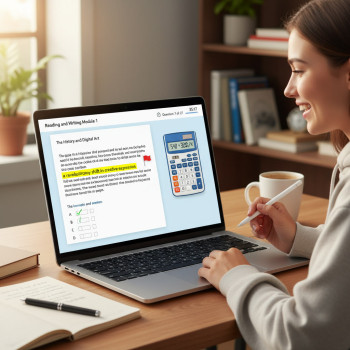Why this guide matters: navigating two education universes toward the same goal
As colleges worldwide still consider the SAT a snapshot of a student’s academic readiness, parents face tricky choices when their child studies under different educational systems. International schools and local boards often deliver contrasting curricula, teaching styles, and timelines. Yet the destination — a strong Digital SAT score and a compelling college application — is shared. This guide walks you through practical, up-to-date strategies for both paths, so you can make clear choices, build confidence, and support your student every step of the way.

Quick primer: what the Digital SAT means for families
Before diving into school-specific advice, let’s set a shared baseline. The Digital SAT is delivered on computers or school-managed devices and emphasizes clarity, efficiency, and accessibility. It’s adaptive in a way that speeds testing and provides more time per question than older formats. Students should become familiar with the Bluebook testing application, how to use an on-screen calculator when allowed, and the rhythms of the test: Reading & Writing and Math sections, shorter test length, and modernized question styles.
Familiarity with the test platform is almost as important as content knowledge—practice on the same kind of device can cut anxiety and boost speed. Many schools and districts now link official practice materials to classroom resources; families in international schools sometimes have different access paths than those in local boards, so we’ll cover what to look for in each context.
Head-to-head: International schools vs local boards — what’s different and why it matters
International schools (including IB, IGCSE, and international American/British curricula) and local board systems (state boards, national boards like CBSE or state exam systems) bring distinct strengths. Consider these general contrasts:
- Curriculum alignment: International schools often teach content in English and emphasize critical thinking, global contexts, and skills-based learning—closely aligned with SAT-style questions. Local boards may emphasize exam-specific syllabi, regional texts, or bilingual instruction; that can mean both advantages (deep subject knowledge) and gaps (less practice with SAT-style critical reading or evidence-based writing).
- Instructional pace and depth: International curricula frequently include extended essay work, research projects, and inquiry-based tasks that mirror college readiness indicators. Local boards can range widely: some are rigorous and broad, others very exam-focused with heavy rote components.
- Test logistics: International schools may offer coordinated SAT test days, on-campus digital testing, or scheduled school-day administrations. Local board students may need to register for weekend sessions or travel to designated test centers; device access and familiarity with Bluebook can vary.
- College counseling resources: Many international schools have structured college counseling and standardized-test support built in. Local board schools often provide counseling too, but resources and counselor-to-student ratios differ.
Why these differences matter for SAT prep
Because the SAT measures both reasoning and skills that are shaped by how students were taught. A student used to extended-response English classes and critical reading will find the SAT’s evidence-based questions friendly; a student from an exam-focused board might excel at math computation but need practice translating word problems into test strategy. The good news: targeted prep bridges these gaps quickly—especially with a personalized plan.
Step-by-step prep roadmap by school type
Below are practical, stage-by-stage roadmaps you can adapt depending on whether your child studies in an international school or under a local board.
For international school students
- Start with diagnostic practice on Bluebook: Even if the school provides in-class prep, encourage your student to take an official practice test on the Bluebook app or similar digital environment. This identifies timing habits and platform comfort early.
- Leverage classroom strengths: If your child already reads widely and writes analytically, convert those strengths into SAT-specific practice—target precision in evidence-based reading and concise, strategic problem solving in math.
- Focus on test strategy: International curricula often cover the content; the gap is usually strategy—how to approach a Reading passage under time pressure or whether to use backsolving on algebra questions. Add timed sections into weekly routines.
- Use school counseling: Coordinate with the college counselor for on-campus test days and device checks. Ask about supervised practice sessions using the school’s devices.
For local board students
- Build familiarity with test language: If instruction uses another language or board-specific texts, spend extra time on SAT-style passages and vocabulary in context. Reading diverse materials (op-eds, science articles, humanities essays) helps.
- Bridge content and format: Translate strengths from board exams (like strong math fundamentals) into the SAT format—practice multi-step word problems and data analysis questions.
- Ensure device readiness: Confirm access to a compatible device and practice on Bluebook early. If your school can’t provide a device, plan a device-borrowing strategy well before test day.
- Seek targeted support: Where school counseling is limited, consider one-on-one support to build test-specific skills and a focused timeline around board exam schedules.
Timing your prep around academic calendars and exams
One of the biggest practical decisions is calendar planning. Board exam periods, IB/IGCSE exam months, and school holidays shape when a student should take the SAT.
Here’s a simple comparative timeline to help you plan (example workflow, adaptable by region):
| Student type | Best time to start prep | Ideal test windows | Notes |
|---|---|---|---|
| International school (IB/IGCSE) | Junior year start (or earlier) with weekly practice | Fall of junior year or spring—avoid exam months | Coordinate with school testing days; use school resources for device practice |
| Local board (state/national) | 6–12 months before intended test date, depending on board exam load | Summer or early fall if boards finish in spring; otherwise post-board windows | Prioritize board exam success first, then SAT build-up; schedule practice on weekends |
How to adapt if board exams collide with SAT planning
It’s common for students to face overlapping test loads. Rule of thumb: prioritize high-stakes board exams that affect graduation, then refocus on SAT prep with a condensed, targeted plan for 6–10 weeks after boards. Short, intense practice blocks (daily 45–60 minute sessions) focusing on weaknesses can produce strong rebounds. If time allows, plan a low-pressure diagnostic test a month after boards to recalibrate.
Study strategies that work across systems
Certain habits benefit every student, regardless of curriculum.
- Consistent, short practice beats irregular marathon sessions: Daily focused work—30–60 minutes—is more effective than occasional all-day drills.
- Practice on the actual platform: Use Bluebook or official digital practice to build comfort with interface, highlighting, and navigation.
- Prioritize weak-to-strong cycles: Target your child’s weakest question types first (e.g., geometry word problems, evidence-based reading). Strengthening low-performing areas often yields the biggest score improvements.
- Mix content review with strategy drills: Combine concept refreshers (algebra rules, grammar conventions) with timed test behavior—skipping strategies, educated guessing, and efficient calculator use.
- Simulate test day: At least two full-length digital practice tests under timed conditions; debrief each test for error patterns rather than just the raw score.
When to seek personalized help (and what to look for)
Every family will wonder whether tutoring is worth it. Personalized support is most valuable when:
- Time is limited because of boards or intensive school commitments.
- The student has plateaued using self-study resources.
- There are gaps in foundational skills that need structured remediation.
Good tutoring is not just more practice; it’s a targeted plan that fits your student’s schedule and learning style. Look for tutors or programs that offer:
- Diagnostic assessments and a clear, individualized study plan.
- 1-on-1 guidance to correct recurring mistakes and build test strategies.
- Flexible scheduling around school and exam calendars.
- Tools that integrate practice data with instruction—so sessions are efficient and proportional to needs.
For families exploring options, Sparkl’s personalized tutoring blends one-on-one guidance, tailored study plans, expert tutors, and AI-driven insights to surface weak areas and track progress. When used alongside official practice on Bluebook and BigFuture planning, such personalized support often accelerates improvement while respecting school commitments.
Practical tips for test day (digital format specifics)
Test day rituals reduce stress. For the Digital SAT, these practical items are key:
- Install and test the Bluebook app on the same device your student will use long before the test day. Practice launching, logging in, and navigating passages.
- Check device battery, chargers, and any permitted external accessories. If the school provides a device, do a device test within the school environment.
- Simulate timing and breaks exactly as the test prescribes so your student knows when to pace, when to use built-in tools, and how to manage fatigue.
- Pack comfort items—water, snacks for long days, ID, and a printed admission ticket if required by the test center.

Interpreting scores and next steps for applications
Once scores arrive, use them to guide college choices and application strategies. Many families worry whether a score from a student in a local board will be fairly interpreted by admissions offices. The answer: colleges consider context. Your child’s transcript, school profile, course rigor, and extracurricular story combine with the SAT to present a holistic picture.
Actionable next steps after receiving scores:
- Compare the score to your target college median; fine-tune a plan for re-testing if needed.
- Use score reports to pinpoint weak areas and target a 4–8 week improvement plan before retest.
- Discuss with your school counselor how test scores will be contextualized in your student’s school profile.
Real-world examples: shifting from board-focused to SAT-ready
Example 1: A student in a national board system excelled in math calculations but struggled with SAT-style word problems. A short series of strategy sessions—one-on-one tutoring focused on translating word problems and timed practice on digital format—moved the student’s math score up by 60 points in two months.
Example 2: An IB student already used to critical analysis needed help with pacing in Reading. Weekly timed passage sets and targeted pacing techniques added comfort: the student learned to spend more time on inference questions and less on passage-skimming, which improved both confidence and score.
These real cases highlight a practical point: the right interventions are often small, precise, and aligned to the testing format.
Equity and access: making digital testing fair
Device access, quiet testing space, and reliable internet (for practice and registration steps) are equity challenges. Parents can advocate for:
- School device lending programs or supervised school-day testing to avoid travel and device barriers.
- Designated practice time during school hours to use managed devices.
- Clear communication from the school on how they’ll support students with accommodations or those who need alternate testing arrangements.
Where school resources fall short, personalized supports (including targeted tutoring and device coaching) can level the playing field. Many tutoring programs also help families understand device requirements and pre-test checks so students aren’t surprised on test day.
Checklist for parents: a month-by-month action plan
This compact checklist helps you stay organized in the 3 months before a planned test date.
- 3 months out: Take a full digital diagnostic; review results; decide whether to self-study or add tutoring. Register test date and verify device compatibility.
- 8 weeks out: Build a weekly schedule with 4–6 practice sessions per week; include one full-length test every two weeks; start targeted tutorials for weak areas.
- 4 weeks out: Increase simulated full-length digital tests to one per week; refine pacing; practice on the actual test platform; finalize logistics for test day.
- Week of test: Light review only; sleep, nutrition, and calm routines matter more than cramming; confirm arrival times and device readiness.
Final thoughts: parents as partners, not project managers
Your role matters most when you support steady routines, celebrate progress, and provide calm structure. Students respond best to confidence, not pressure. Keep conversations focused on growth and strategies rather than just scores. Help your child develop a small set of achievable goals—weekly practice milestones, a target score, and a clear plan for test day—and then let them lead their daily work.
If you find gaps between school supports and your student’s needs, consider a short-term, personalized coaching plan. Sparkl’s model of 1-on-1 guidance, tailored study plans, expert tutors, and AI-driven insights fits naturally here: targeted intervention that respects your student’s calendar, closes specific gaps, and builds measurable momentum without overwhelming the family schedule.
One last practical score-building tip
When time is short, micro-learning wins: 20–30 minute sessions focusing on a single question type (e.g., data interpretation, grammar-in-context, or linear equations) every day for two weeks yields bigger score changes than infrequent long sessions. Use official digital practice questions and debrief each mistake—understanding why an answer is wrong is often more instructive than knowing why one is right.
Resources to keep handy
- Official digital practice (Bluebook-style simulations) for platform familiarity.
- BigFuture planning tools to map test dates and target colleges.
- School counseling appointments for local context and school profile guidance.
- Personalized tutoring for targeted remediation—especially helpful when balancing board exams and SAT prep.
Closing: a calm, confident path forward
Preparing for the Digital SAT while navigating either an international school or a local board system is a manageable project with the right roadmap. Match strategy to context: use the critical thinking strengths of international curricula; shore up test-format familiarity for local board students; prioritize official digital practice; and lean on targeted, personalized support when schedules or skill gaps require it. With steady planning and focused, empathetic support from parents, students can approach test day calm, prepared, and ready to let their true academic potential shine.
Take a breath, make a simple plan, and remember this is one chapter in a much larger college story—your child’s resilience, curiosity, and voice will matter far beyond any score.















No Comments
Leave a comment Cancel